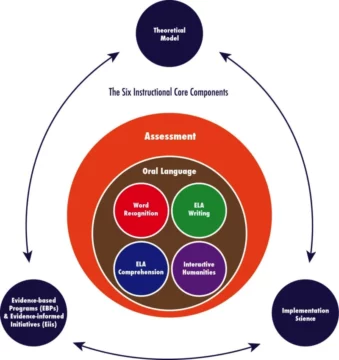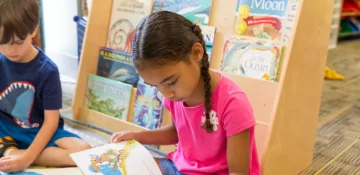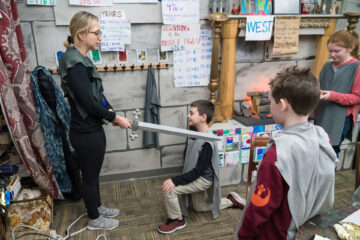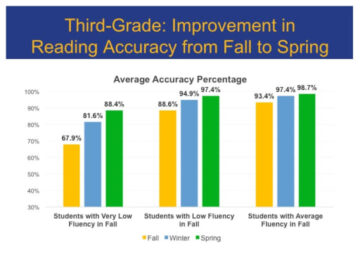AIM’s Integrated Literacy Model (ILM) was designed to ensure that all students experience learning opportunities optimal for developing literacy skills. Recognizing that no single “off the shelf” program sufficiently addresses the continuum of skills necessary to develop proficient readers and writers, the ILM brings together evidence-based programs and initiatives aligned to six core instructional components. Additionally, the ILM leverages implementation science to give teachers the strategies they need to translate evidence-based literacy programs into practice within their classrooms faithfully and sustainably.
The Integrated Literacy Model was developed within AIM Academy, a research-to-practice school serving students with language-based learning differences. Currently, only AIM Academy implements the comprehensive model, while more than 14,000 teachers participate in AIM Institute’s Pathway Courses to learn select literacy practices that comprise the model. AIM Integrated Literacy Model Summary The AIM Pathways™ Difference
What Makes This Model Innovative?
Rigorous Learning
High Expectations with Unlimited Opportunities
Relevance
Goals
The Integrated Literacy Model is implemented at AIM Academy, where 100% of students have language-based learning differences. Its ultimate goal is to develop all students into proficient readers and writers, including those who learn differently.
Proficient Readers and Writers
In the early grades, students develop foundational skills such as word recognition, fluency, and the fundamentals of reading comprehension and written expression. In the upper grades, students develop lifelong literacy skills related to critical thinking, prediction, inference, and reflection.
Experience
 Based on Scarborough’s Reading Rope (2001), the Integrated Literacy Model anchors on six instructional core components teachers must implement with fidelity to develop students into proficient readers and writers. The model identifies evidence-based instructional practices aligned to the core components and leverages implementation science to ensure teachers properly learn how to apply them in their classrooms. It is the consistent and integrated application of these components across the school day that supports all students to achieve literacy proficiency, including those with learning differences. Scarborough’s Reading Rope
Based on Scarborough’s Reading Rope (2001), the Integrated Literacy Model anchors on six instructional core components teachers must implement with fidelity to develop students into proficient readers and writers. The model identifies evidence-based instructional practices aligned to the core components and leverages implementation science to ensure teachers properly learn how to apply them in their classrooms. It is the consistent and integrated application of these components across the school day that supports all students to achieve literacy proficiency, including those with learning differences. Scarborough’s Reading Rope
The six components are:
- Assessment
- Oral Language
- Word Recognition
- ELA Comprehension
- ELA Writing
- Interactive Humanities
Assessment is foundational to all other components in the model because providing differentiated literacy instruction requires baseline screening data and ongoing analysis of student skills and growth areas. In the ILM, students are assessed three times per year using research-based screeners and diagnostics. In between, these data-driven teachers also use a variety of formal and informal measures (e.g., informal decoding surveys and decision-making flowcharts) to understand learner needs and create differentiated groupings for targeted instruction.
In the ILM, students develop skills in all four language modalities: speaking, listening, reading, and writing. However, students practice oral language first—through simple techniques such as “turn and talks” as well as through formal presentations—because oral language provides the foundation for all written language, both receptive (reading) and expressive (writing).
In the ILM, students develop word recognition through a structured literacy program. They learn elements of phonological awareness, decoding, and encoding, ultimately leading to the goal of sight recognition to support automatic reading of connected text. Throughout the direct instruction, students work from the smallest units to the largest to read and spell sounds, words, sentences, and connected text. At each level, students build accuracy initially, and with practice, they strive to achieve automaticity since this is critical for comprehension.
 ELA Comprehension utilizes a comprehension blueprint to target the critical subskills of background knowledge, vocabulary, verbal reasoning, language structures, and literacy knowledge. Students interact deeply with complex texts through theme-based, standards-aligned units to build knowledge and skills that support comprehension across all content areas, including math. Scaffolding and accommodations ensure that students access grade-level texts that are often above their independent reading level. For example, teachers engage in interactive read-alouds of complex texts so that decoding challenges do not prevent access to grade-level content.
ELA Comprehension utilizes a comprehension blueprint to target the critical subskills of background knowledge, vocabulary, verbal reasoning, language structures, and literacy knowledge. Students interact deeply with complex texts through theme-based, standards-aligned units to build knowledge and skills that support comprehension across all content areas, including math. Scaffolding and accommodations ensure that students access grade-level texts that are often above their independent reading level. For example, teachers engage in interactive read-alouds of complex texts so that decoding challenges do not prevent access to grade-level content.
In the early years of elementary school, young students develop foundational skills within the writing cycle (planning, organizing, composing, reviewing, revising, and editing) through direct instruction. As they progress through grade levels, the skills become more complex but the overall process remains. Across the curriculum, students learn to write for a variety of purposes and genres. They are active participants in setting writing goals and monitoring their growth.

Interactive Humanities is a highly scholastic, arts-based approach that develops literacy skills across academic disciplines, including civics, geography, history, and literature. Students are immersed in a time period, wearing costumes as they discover historical events, learn key vocabulary, and participate in art projects.
The Interactive Humanities curriculum is designed thoughtfully so that it builds students’ background knowledge, preparing them to encounter these concepts in other parts of their educational journey. As an example, in 6th grade, students explore ancient civilizations and recreate key artifacts. Three times each year, they act as docents, guiding visitors through the development of ancient civilizations and world religions.
Supporting Structures
AIM’s Integrated Literacy Model provides consistent structured opportunities for students to develop their literacy skills. Full integration of the model requires commitment and openness to learning as well as a willingness to change.
School leaders and teachers must make updated, informed decisions about the curriculum and assessment materials they use.
To successfully implement the ILM, schools must audit their instructional materials to ensure that they meet expectations for alignment to college- and career-ready standards. AIM recommends using reputable platforms like EdReports to select high-quality instructional materials, screeners, and assessments. EdReports
For word recognition in particular, schools must use a structured literacy curriculum aligned with the Orton-Gillingham approach to teach foundational skills. This is an explicit, systematic, and cumulative approach that benefits all students, in particular those for whom reading, writing, and spelling do not come easily, such as those with dyslexia. If emphasis on direct instruction in decoding and spelling is lacking from the selected curriculum, then a supplemental phonics curriculum will be necessary.
Teachers must also receive strong, ongoing training in using the materials they select so that they are implemented with fidelity. See more under Adult Roles, Hiring, & Learning.
In the Integrated Literacy Model, all teachers are literacy teachers.
Adult Roles & Hiring: The Interactive Humanities teaching role is unique to the ILM and is often filled by people with significant background and interest in studio and/or dramatic arts. This class is separate from more traditional art classes, which students take on rotation.
Learning: Every educator in a school that implements the Integrated Literacy Model is responsible for teaching literacy and must therefore receive comprehensive training. To that end, AIM Institute has designed a continuum of professional learning opportunities for teachers and leaders called AIM Pathways™. As a first step, school leaders complete a course called Pathways for Literary Leadership that prepares them to introduce a culture of literacy to their school or district and teachers take an online course called Pathways for Proficient Reading.
Pathways™ courses guide participants through a learn-practice-apply cycle to ensure they are prepared to translate theoretical models into classroom practice. They also include access to Virtual Community of Practice Coaching sessions where participants can connect and learn with one another across schools. AIM Pathways AIM Pathways Overview NCTQ’s The Four Pillars to Reading Success
Students have time allocated every day to word recognition, ELA comprehension, ELA writing, and differentiated instruction (intervention and enrichment).
In the ILM, students experience literacy across the curriculum every day. In addition, there are blocks of time allocated to specific focus areas. Though represented individually, ELA is a 60- to 90-minute block that integrates both reading and writing. Here is a sample of the lower school schedule:
- 30-45 minutes of word recognition
- 30-45 minutes of ELA reading comprehension
- 30-45 minutes of ELA writing
- 30-45 minutes of intervention and enrichment in small groups of 1:1
- 30-45 minutes of Interactive Humanities
In the Integrated Literacy Model, parents are encouraged to extend learning opportunities for students.
AIM partnered with an organization called Read by 4th, a Philadelphia-based early literacy movement, and Drexel University to design workshops for parents to support early reading that schools interested in implementing the ILM may be interested to explore. Read by 4th Initiative
Interactive Humanities requires dedicated space in the classroom that teachers design to facilitate immersive experiences.
In the ILM at AIM Academy, Interactive Humanities teachers transform small, stand-alone classrooms into spaces reflecting the historical time period they are studying (e.g., ancient Greece) so that students who step inside feel as though they are traveling through time.
Schools without access to these stand-alone spaces must dedicate part of a classroom area to Interactive Humanities work. Teachers can enhance the immersive experience by using costumes or requiring students to present “passports” to step into that portion of the room.
Students receive supplemental, differentiated literacy support through the use of 1:1 technology.
Each elementary student has a school-issued iPad, and each student in 5th grade and above has a school-issued computer. While not required, regular access to technology allows teachers to supplement in-class literacy instruction with engaging individualized lessons that students can complete during their free time. Additionally, 1:1 technology ensures easy access to literacy tools such as audio books and dictation software for students who need them.
School leaders and teachers must make updated, informed decisions about the curriculum and assessment materials they use.
To successfully implement the ILM, schools must audit their instructional materials to ensure that they meet expectations for alignment to college- and career-ready standards. AIM recommends using reputable platforms like EdReports to select high-quality instructional materials, screeners, and assessments. EdReports
For word recognition in particular, schools must use a structured literacy curriculum aligned with the Orton-Gillingham approach to teach foundational skills. This is an explicit, systematic, and cumulative approach that benefits all students, in particular those for whom reading, writing, and spelling do not come easily, such as those with dyslexia. If emphasis on direct instruction in decoding and spelling is lacking from the selected curriculum, then a supplemental phonics curriculum will be necessary.
Teachers must also receive strong, ongoing training in using the materials they select so that they are implemented with fidelity. See more under Adult Roles, Hiring, & Learning.
In the Integrated Literacy Model, all teachers are literacy teachers.
Adult Roles & Hiring: The Interactive Humanities teaching role is unique to the ILM and is often filled by people with significant background and interest in studio and/or dramatic arts. This class is separate from more traditional art classes, which students take on rotation.
Learning: Every educator in a school that implements the Integrated Literacy Model is responsible for teaching literacy and must therefore receive comprehensive training. To that end, AIM Institute has designed a continuum of professional learning opportunities for teachers and leaders called AIM Pathways™. As a first step, school leaders complete a course called Pathways for Literary Leadership that prepares them to introduce a culture of literacy to their school or district and teachers take an online course called Pathways for Proficient Reading.
Pathways™ courses guide participants through a learn-practice-apply cycle to ensure they are prepared to translate theoretical models into classroom practice. They also include access to Virtual Community of Practice Coaching sessions where participants can connect and learn with one another across schools. AIM Pathways AIM Pathways Overview NCTQ’s The Four Pillars to Reading Success
Students have time allocated every day to word recognition, ELA comprehension, ELA writing, and differentiated instruction (intervention and enrichment).
In the ILM, students experience literacy across the curriculum every day. In addition, there are blocks of time allocated to specific focus areas. Though represented individually, ELA is a 60- to 90-minute block that integrates both reading and writing. Here is a sample of the lower school schedule:
- 30-45 minutes of word recognition
- 30-45 minutes of ELA reading comprehension
- 30-45 minutes of ELA writing
- 30-45 minutes of intervention and enrichment in small groups of 1:1
- 30-45 minutes of Interactive Humanities
In the Integrated Literacy Model, parents are encouraged to extend learning opportunities for students.
AIM partnered with an organization called Read by 4th, a Philadelphia-based early literacy movement, and Drexel University to design workshops for parents to support early reading that schools interested in implementing the ILM may be interested to explore. Read by 4th Initiative
Interactive Humanities requires dedicated space in the classroom that teachers design to facilitate immersive experiences.
In the ILM at AIM Academy, Interactive Humanities teachers transform small, stand-alone classrooms into spaces reflecting the historical time period they are studying (e.g., ancient Greece) so that students who step inside feel as though they are traveling through time.
Schools without access to these stand-alone spaces must dedicate part of a classroom area to Interactive Humanities work. Teachers can enhance the immersive experience by using costumes or requiring students to present “passports” to step into that portion of the room.
Students receive supplemental, differentiated literacy support through the use of 1:1 technology.
Each elementary student has a school-issued iPad, and each student in 5th grade and above has a school-issued computer. While not required, regular access to technology allows teachers to supplement in-class literacy instruction with engaging individualized lessons that students can complete during their free time. Additionally, 1:1 technology ensures easy access to literacy tools such as audio books and dictation software for students who need them.
Supports Offered
AIM Institute for Learning & Research offers the following support to help you implement their approach.
Direct Consulting
Cost Associated
To launch the Integrated Literacy Model, schools must participate in a combination of virtual and in-person learning opportunities, including scaffolded coaching.
AIM Institute offers implementation consulting, including literacy audits, needs assessments for schools and districts looking for literacy training opportunities, coaching frameworks, assessments, AIM Academy site visits, and support for sustainable implementation.
AIM Pathways™
Cost Associated
AIM Pathways™ is an interactive digital teacher training platform designed to deliver research and evidence-based content in the science of reading. These courses were created based on the highly successful curriculum model designed and implemented at AIM Academy. Schools or teachers interested in learning more about one or more of the six components of the Integrated Literacy Model can enroll in one of the following virtual courses:
- Pathways to Proficient Reading
- Pathways to Literacy Leadership
- Pathways to Proficient Writing
- Pathways to Structured Literacy
Reach
Impact
In 2018, Georgia State University analyzed AIM Academy’s historical reading accuracy and fluency data for 2nd- through 5th-grade students. They learned the following:
 Students with very low fluency in the fall (67.9%) reached 88.4% accuracy by spring.
Students with very low fluency in the fall (67.9%) reached 88.4% accuracy by spring.- Students with low fluency in fall (88.6%) reached 97.4% accuracy by spring.
- Students with average fluency in fall (93.4%) reached 96.7% accuracy by spring.
- Over 60% of 2nd- through 5th-grade students showed faster than predicted rates of improvement from fall to spring compared to national norms, reaching 76% for 3rd-graders.




 Students with very low fluency in the fall (67.9%) reached 88.4% accuracy by spring.
Students with very low fluency in the fall (67.9%) reached 88.4% accuracy by spring.